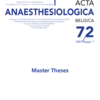Confirming central line position through bedside ultrasound, a prospective registration
Anesthesia; central venous catheter; ultrasound
Published online: Apr 21 2022
Abstract
Objective: Ultrasound (US) techniques are common practice for the placement of central venous catheters (CVC). Although chest X-ray (CXR) is still the golden standard for confirmation of a correct position, ultrasonic alternatives have been proposed.
Methods: A prospective observational 2 center study to evaluate the feasibility and accuracy of bedside US techniques to confirm the CVC tip position. Four different approaches were assessed: (i) occurrence of extrasystoles (ES), (ii) direct vascular US of the subclavian and jugular veins, (iii) observation of the guidewire in the right atrium and (iv) indirectly with visualization of the Rapid Arterial Swirl (RAS) - sign. Lung US is performed to diagnose a potential pneumothorax (PTX). As reference, the CXR protocol made by a radiologist was used.
Measurements and main results: 131 patients were included. Ten suboptimal CVC tip placements were detected by CXR. Occurrence of ES and vascular US are feasible bedside tests (resp, 96% and 97%), whereas the feasibility of the subcostal view of the heart is much more cumbersome (83%-84%). Chi-Square analysis shows a specificity of 100% with the occurrence of ES during placement, whereas vascular US shows a high sensitivity of 99%. If feasible, visualization of the guidewire and RAS is seen to be specific (both 100%) for a correct CVC position. The 4 methods are put together in 5 flowcharts, allowing us to possibly reduce CXR up to 77.5 percent. No conclusion can be made about the accuracy of lung US, considering the low incidence of PTX, although the one PTX that occurred was not diagnosed by US.
Conclusion: The four bedside approaches each have their own feasibility and use in confirming CVC position and putting them all together might reduce the need for CXR. The provided flowcharts can be used as a firsthand tool to safely avoid CXR after CVC placement.
